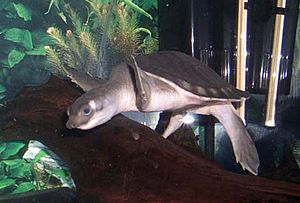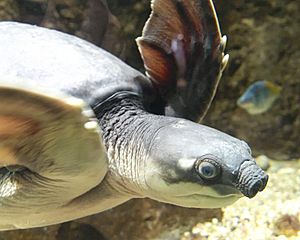Pig-nosed turtle facts for kids
Quick facts for kids Pig-nosed turtle |
|
|---|---|
 |
|
| A young individual in captivity in Slovakia. | |
| Conservation status | |
| Scientific classification | |
| Kingdom: | |
| Phylum: | |
| Class: | |
| Order: | |
| Suborder: | |
| Superfamily: |
Trionychia
|
| Family: |
Carettochelyidae
|
| Subfamily: |
Carettochelyinae
|
| Genus: |
Carettochelys
|
| Species: |
C. insculpta
|
| Binomial name | |
| Carettochelys insculpta Ramsay, 1886
|
|
| Synonyms | |
|
|
The pig-nosed turtle (Carettochelys insculpta) is a special kind of turtle found in northern Australia and southern New Guinea. People also call it the pitted-shelled turtle or Fly River turtle. It's quite unique among freshwater turtles because it has features similar to sea turtles.
Contents
About the Pig-Nosed Turtle
The pig-nosed turtle looks different from other freshwater turtles. Its feet are shaped like flippers, just like those of sea turtles. Its nose looks like a pig's snout, with the nostrils right at the end of a fleshy nose. This is how it got its common name!
The top shell, called the carapace, is usually grey or olive. It feels leathery. The bottom shell, called the plastron, is cream-coloured. Male pig-nosed turtles have longer and thinner tails than females. These turtles can grow to about 70 cm (28 inches) long and weigh over 20 kg (44 pounds).
Unlike some other turtles with soft shells, pig-nosed turtles have a strong, bony shell under their leathery skin. Their bottom shell is also solid and strongly connected to the top shell.
How Pig-Nosed Turtles Behave
Pig-nosed turtles spend most of their lives in water, but they are not completely aquatic. Scientists don't know a lot about their behavior in the wild because they are hard to study. However, they seem to be more territorial than many other turtles. This means they like to have their own space.
During the cooler dry season, they sometimes gather around warm spots in the rivers. This suggests they might have some kind of social structure.
What Do Pig-Nosed Turtles Eat?
The pig-nosed turtle is an omnivore, which means it eats both plants and animals. They enjoy a variety of foods, including fruit and leaves from fig trees. They also eat small animals like crustaceans (like crabs), molluscs (like snails), and insects.
Life Cycle and Reproduction
Female pig-nosed turtles are ready to lay eggs when they are about 18 years old or older. Males are ready around 16 years old. They lay their eggs late in the dry season on sandy river banks.
When the baby turtles inside the eggs are fully grown, they wait. They stay in a kind of hibernation until the conditions are just right to hatch. Hatching can be triggered by the eggs being flooded with water or by a sudden drop in air pressure, which signals a storm is coming.
This way of hatching, using environmental triggers and vibrations from other hatching turtles in the same group, helps them survive. When all the turtles hatch at the same time, it gives them safety in numbers. Also, the more turtles that hatch, the more help they have to dig through the sand to reach the surface.
Where Pig-Nosed Turtles Live

Pig-nosed turtles live in freshwater streams, lagoons, and rivers. You can find them in the Northern Territory of Australia. They also live on the island of New Guinea, especially in the larger rivers that flow south.
See also
 In Spanish: Tortuga boba papuana para niños
In Spanish: Tortuga boba papuana para niños



